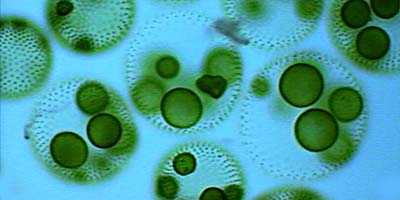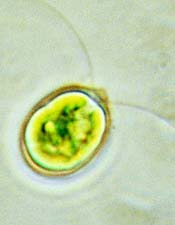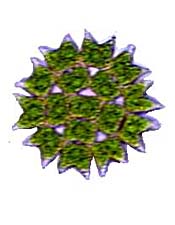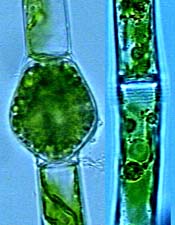Introduction to the Chlorophyceae
fresh-water green algae


The Chlorophyceae are a large and important group of freshwater green algae. They include some of the most common species, as well as many members that are important both ecologically and scientifically.
There are approximately 350 genera and 2650 living species of chlorophyceans. They come in a wide variety of shapes and forms, including free-swimming unicellular species, colonies, non-flagellate unicells, filaments, and more. They also reproduce in a variety of ways, though all have a haploid life-cycle, in which only the zygote cell is diploid. The zygote will often serve as a resting spore, able to lie dormant though potentially damaging environmental changes such as dessication.
The Chlorophyceae includes three major groups distinguished primarily by basic differences in the arrangement of their flagellae:
 |
 |
 |
Chlorophycean Diversity : Above are shown representatives of the three major groups of Chlorophyceae. From left to right, these are Chlamydomonas (Volvocales); Pediastrum (Chlorellales); and Oedogonium (Oedogoniales). The pictures also serve to show some of the structural diversity of chlorophyceans; these are (again, from left to right): unicells, colonies, and filaments.
Perhaps the most famous and important chlorophyceans are Chlamydomonas and Volvox. Both are important research organisms in biological laboratories. Volvox, pictured at the top of this page, is a model organism for understanding cell death and cell interactions. Chlamydomonas, pictured above at left, though tiny and single-celled has been useful in countless studies, including freshwater ecology, cell division, physiology, genetic structure and function, and genomic evolution.
No less important are the Chlorellales, especially Chlorella. Though only about ten species are known in this genus, it plays an important role as endosymbionts inside the tissues of other organisms. Sponges, polyps, ciliates, and forams all may house Chlorella internally, providing a home for the alga in exchange for its photosynthates. More recently, this tiny alga has become popular as a "health food" for its concentrated proteins and chlorophyll, and is now raised commercially in large numbers, especially in Asia.
Many other species of Chlorophyceae are common. Oedogonium grows in freshwater worldwide, usually attached to other plants or algae; it has been a subject of intense study for its unusual cell division method. Species of Chlorococcales are frequently found in soil or mud, and some, such as Apatococcus may be found growing in bright green patches on walls and the sides of trees where moist conditions prevail.
The oldest fossils resembling Chlorophyceans come from the Proterozoic Bitter Springs Formation of central Australia. There is insufficient preservation to make a firm identification of these fossils, but other multicellular algae are known from this time (Butterfield et al. 1988), so the identification is not unreasonable.
More likely fossils of this group have been found in Middle Devonian rocks from New York State (Baschnagel 1966). Among these is Paleooedogonium, a fossil with striking resemblance to modern Oedogonium. The presence of this fossil and those of other freshwater green algae in the Devonian suggests that the group was quite diverse by this time.
Tertiary fossils of modern chlorophycean genera are also known, such as Scenedesmus in the Chlorellales (Fleming 1989), Pediastrum and Botryococcus (Gray 1960), and Tetraedon (Goth et al. 1988). The last of these is believed to be an important component in the formation of oil shales of the Tertiary, such as those in Messel, Germany.
Visit the Protist Image Data Base for pictures and information about Chlamydomonas.
AGIS maintains a database on Chlamydomonas research. There is also a site at Brandeis on cell fate determination using Volvox as a model organism.
Images on this page courtesy of the Virtual Foliage collection at the University of Wisconsin-La Crosse. They are used by permission, and should not be duplicated.

N.J. Butterfield, A.H. Knoll, & K. Swett. 1988. Exceptional preservation of fossils in an Upper Proterozoic shale. Nature 334:424-427.
R.F. Fleming. 1989. Fossil Scenedesmus (Chlorococcales) from the Raton Formation, Colorado and New Mexico, USA. Review of Palaeobotany and Palynology 59:1-6.
K. Goth, J.W. de Leeuw, W. Püttmann, & E.W. Tegelaar. 1988. Oil of Messel Oil Shale kerogen. Nature 336:759-761.
Jane Gray. 1960. Fossil Chlorophycean algae from the Miocene of Oregon. Journal of Paleontology 34(3):453-463.
C. Van den Hoek, D. G. Mann, & H. M. Jahns. 1995. Algae: an Introduction to Phycology. Cambridge Univ. Press, Cambridge.

